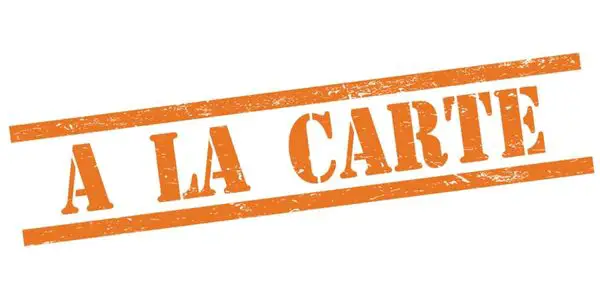The process of determining the value the seller will receive in the exchange of goods and services requires to be suitable for both manufacturer and the customer. Setting the price value of a product is a result of a complex set of calculations, research, risk-taking ability, and understanding. But, what is a la carte pricing? Why should you use an a la carte pricing model?
A la carte pricing is a model for customers with customized needs. It includes substantiated prices Instead of a single plan where you select only those features your business requires.
Here we will highlight what a la carte pricing is all about, how the a la carte pricing model works, the benefits of the pricing model, pros and cons compared to other pricing models.
What is a la carte pricing?

An a la carte pricing is a pricing model for customers with customized requirements. Customers, usually enterprise businesses, develop a buying price based on the products and services their businesses require. For instance, most VoIP service providers offer plans with separately priced features. Instead of a single plan with bundled pricing, you may choose a la carte pricing, where you select only those features your business requires.
Knowing how to use the a la carte pricing model might be a challenge, but once you master it, the pricing model might increase your revenue through add-ons from customers.
Why should you use an a la carte pricing model?
So if you plan to alter your current pricing structure by incorporating the a la carte pricing model, this section outlines some fantastic benefits for your business.

Competitive advantage over your competitors
An a la carte pricing model can help your business stay ahead of the competition. The pricing model is one of the best ways to experiment with various options for your products and services, allowing you to determine which options are popular with your clients. You will become an industry leader once you identify the options that your competitors are not offering.
Customer satisfaction
Another benefit of the a la carte pricing model is customer satisfaction. Your customers will feel happy if you allow them to choose what they want rather than forcing them to accept the whole package with bundled pricing. For instance, an a la carte pricing model for purchasing a VoIP phone service allows customers to choose individual options such as unlimited calls and SMS or video conferencing instead of forcing them to subscribe to an entire plan with advanced features they may not need.
Help you understand the market.
Adopting an a la carte pricing system in your business can help you gain market insights such as your customers’ buying behavior. Knowing what your target customers are interested in purchasing will inform your production decisions. For instance, if your target customer prefers a VoIP phone system with the most integration, you may start adding more integration with separate fees. You can channel your marketing effort on that feature, attracting new customers.
Reduce the cost of inventory
Holding too much inventory might cost you more money than you would recoup from the inventory or take up valuable space in your warehouse. Your customers no longer need stock is the most costly inventory your business can have. Implementing a la carte pricing is one of the proven ways of reducing the cost of inventory. Your business will start stocking products that your consumers buy, not those that are “likely” to be purchased.
Is a la carte more expensive?
For consumers, choosing products or services, a la carte is more expensive than packaged pricing or any other pricing model. This is because you are paying for individual options which are separately priced. Since the entire package tends to have higher margins, the company increases the price of the a la carte options to compensate for it.
Package pricing vs. a la carte pricing; which is better?
This section explores the pros and cons of package pricing and a la carte pricing to help you clearly understand which of these pricing models may be best for you. Read on to learn more.
A la carte pricing pros

Lower starting costs
A la carte pricing strategy advocates breaking the entire package into smaller options. Instead of budgeting for a complete package that might be costly for your business, you can budget for components that your customers need.
It’s more flexible
The a la carte pricing model is flexible because it allows customers to choose what they want. Your business can cater to the client’s needs thanks to its flexibility.
Increased revenue
Selling more means lots of revenue for your business. Your products or services are likely to move quickly compared to when sold in complete packages. Breaking down the entire package for your business or services into individual components creates more purchase opportunities.
Positions you as an industry leader.
When you sell products and services a la carte, you take your time to work on the individual options that your customers need. Ensuring your customers have a fantastic experience with your options will likely position you as an industry leader.
A la carte pricing cons
Riskier
You are likely to increase sales, but there is no guarantee on many components your customers will buy and the amount you will raise from the purchases.
It cannot work for some customers.
For instance, a la carte pricing might not be an ideal pricing model for wedding clients looking for photography services since it is confusing.
More interactions with clients
Since your customers will choose individual components for your products or services, you will be forced to interact with them more than once.
Package pricing pros
Easier to forecast revenue
It’s easier to know how much you have made when you sell an entire package once to your customers. You will know how much you will make during a specific period.
No need to rebook
Package pricing is a perfect choice for customers who hate rebooking for more services or those who hate discussing the prices of products or services before purchase. You will likely make more sales from customers who like booking the total package at once.
Creates perceived value
Your business will likely create a perceived file with package pricing compared to other pricing models. The best way to create a perceived value is to create a higher price for any particular component on your “add-on” options price chart. You can determine the actual value of the items when bundled together compared to when they were bought a la carte.
Easier to funnel
Human psychology plays in your favor when you develop multiple package options for your products or services. You will likely pull your customers towards the high-priced packages, which tend to have more enticing features.
Package pricing cons
Less revenue
Package pricing often leads to decreased revenue per client since it advocates for a single point of the sale. It doesn’t allow your customers to meet again and buy additional components that your businesses might have re-introduced or launched as an upgrade to the previous package.
Bundle risk
If you add components in your packages that your customers don’t want, you are hurting your business and not helping your customers.
| A la carte pricing | Package pricing | |
| Revenue | Potential revenue increase | Potential revenue decrease |
| Revenue focusing | Not easy to focus on revenue | Easier to forecast revenue |
| Funneling | Not easy to funnel | Easier to funnel |
| Selling behavior | Repeated sales | One-time-sale |
| Perceived value | It does not create perceived value | Creates perceived value |
As you can see from the above comparison, there are many reasons why one pricing model might work better for your business than the other. Determining what pricing model works best for your business and clients is critical.
